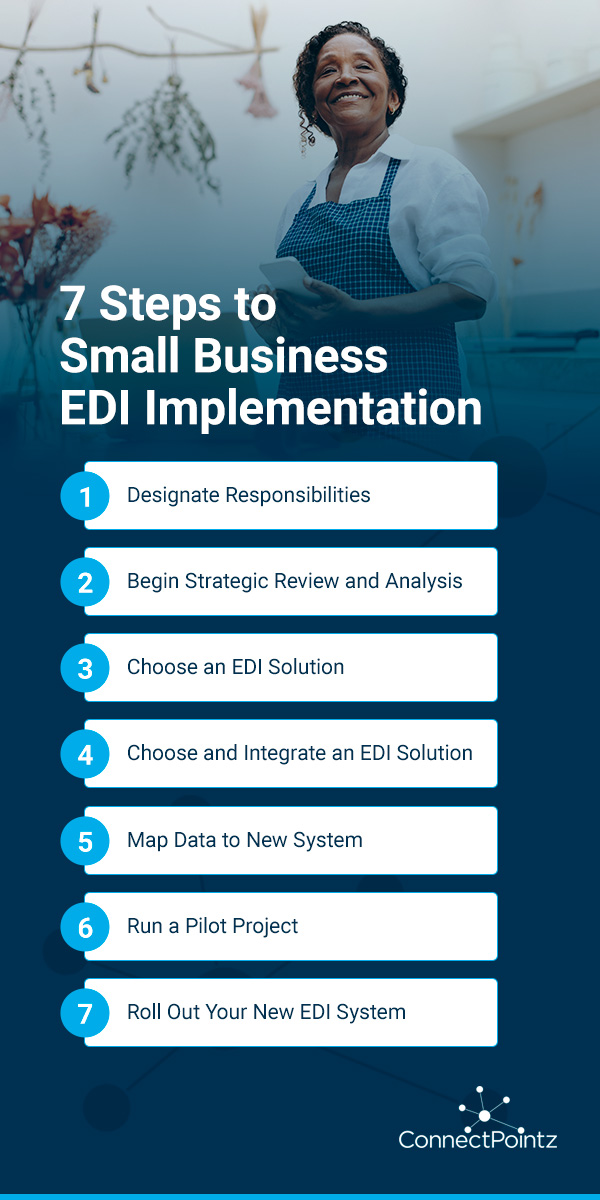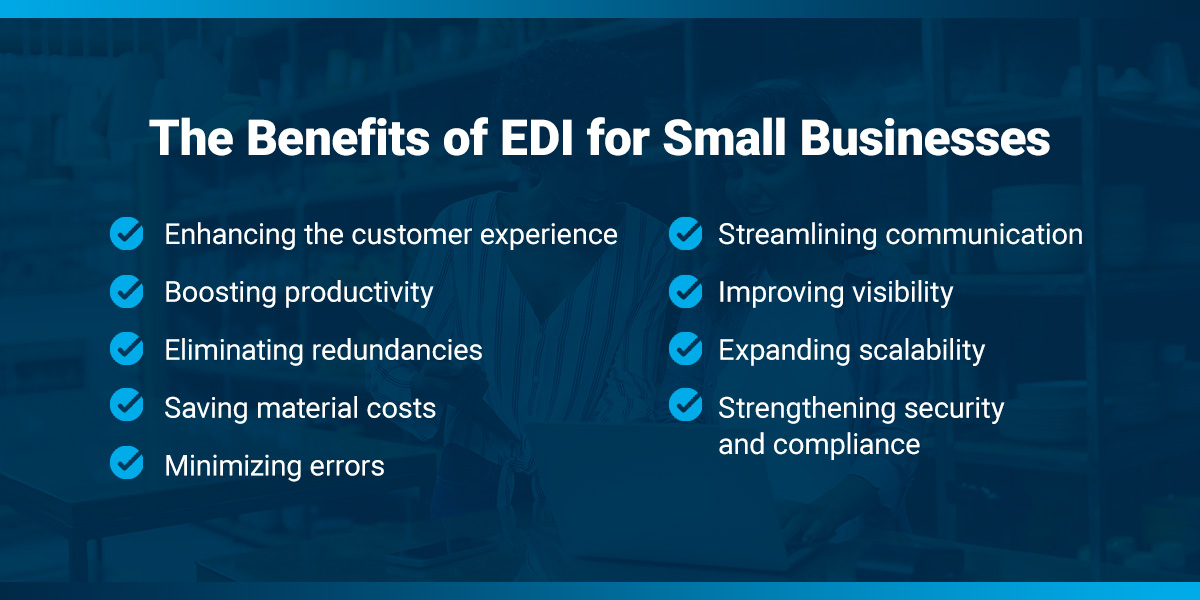
Clear, efficient communication is a critical aspect of forming strong business relationships. Each transaction depends on a successful exchange of many different business documents, from purchase orders to invoices — and with the increasing speed of business today, investing in electronic real-time communication is more important than ever.
That's where electronic data interchange (EDI) comes in. While adopting a new EDI solution is a complex process, businesses of any size can benefit from implementing it in their systems.
This guide will explain everything you need to know about how to implement EDI for a small business like yours.
What Is EDI?
EDI is an electronic system that converts everyday business documents into a format that's compatible with the software your business partners use.
For example, a retailer might use EDI to send a digital purchase order to their supplier. Before it reaches the supplier's internal system, the retailer's EDI solution will translate the purchase order data according to the standard the supplier's system uses.
Companies may use any of a wide variety of EDI standards based on their industry and business model:
- ANSI ASC X12: The American National Standards Institute (ANSI) commissioned the development of this standard from the Accredited Standards Committee (ASC) in 1979. It's currently one of the most widely used EDI standards.
- UN/EDIFACT: If you're exchanging data with international business partners across different industries, you may need to use the United Nations/Electronic Data Interchange for Administration, Commerce and Transport (UN/EDIFACT). It's especially common among European companies, though you might find some users in Asia.
- EANCOM: The European Article Number Communication (EANCOM) standard is a derivative of the UN/EDIFACT standard specifically developed for exchanging supply chain and logistics data in the retail and consumer goods industries. Construction and healthcare companies have also recently begun adopting this standard to track transactions.
- VICS: The Voluntary Inter-industry Commerce Standard (VICS) is a derivative of the ANSI ASC X12 that enables efficient communication between North American retail companies and their suppliers.
When you consider that each of the above standards also has several different versions that get updated over time, implementing EDI might seem like an overly complex task. With the right tools and expertise by your side, though, it can be very manageable.
Working with a reliable EDI service provider is key for implementation success in small businesses. Your provider can take on or automate tasks outside your employees' areas of expertise, which can help improve your chances of ongoing success.
How Do Small Businesses Use EDI?

The idea that only enterprise businesses use EDI is a common misconception. In reality, EDI can help companies of all sizes improve process efficiency, streamline business partnerships and reduce material costs.
Some common small business EDI applications include:
- Money transfers: Financial institutions and fintechs often use EDI to electronically transfer funds between systems.
- Inventory control: EDI can help retail and supply chain management businesses share information about inventory levels at different locations.
- Benefits coordination: Healthcare and insurance companies use EDI to share policy terms, claims documents and more.
- Payment processing: Businesses can use EDI to digitally exchange payment information without having to reformat the incoming documents.
- Shipment tracking: Businesses in manufacturing, retail and third-party logistics use EDI to share updates about shipment location and status changes.
- Invoicing: Any business that bills customers for products or services can use EDI to accelerate invoice processing and improve their cash flow.
7 Steps to Small Business EDI Implementation

Adopting EDI is a significant investment, and it's an essential one for many smaller businesses looking to keep up with their trading partners — especially for those that regularly work with large or enterprise companies.
Here's a brief overview of the steps involved in implementing EDI for small businesses.
1. Designate Responsibilities
First, you'll need to assemble the group of people who will be responsible for planning and executing your implementation. Clearly outlining roles and responsibilities for each member of your team streamlines the process by ensuring everyone understands what they need to be doing.
The roles you'll need to fill include:
- EDI coordinator: This individual is an experienced IT professional with sufficient EDI expertise who will lead your organization through the implementation process. If your business lacks someone who has this kind of experience, you can outsource this role to someone outside your organization.
- Steering committee: The EDI coordinator leads this group in determining your organization's priorities for the implementation process. Typically, your EDI steering committee will include any leaders whose departments will be affected by the EDI adopting, including IT heads and legal representatives.
- Senior management sponsor: Choose a member of senior management to sponsor the project and encourage support from the rest of your organization. This individual is essential for getting buy-in from important stakeholders like your employees and your IT department.
- Dedicated implementation team: This group will be responsible for the implementation process and may include members of the steering committee and/or your senior management sponsor, depending on the size of your organization.
2. Begin Strategic Review and Analysis
The goal in this step is to identify the areas in your business where EDI will have the biggest impact so you can clearly prioritize the steps in your implementation process.
Your steering committee and EDI coordinator will work together to evaluate your company's workflows at every level, from procurement to sales, to determine which areas are most ready for EDI.
The following evaluations are essential for understanding EDI's applications in your business:
EDI survey: An EDI survey confirms that your EDI system is compatible with the business partners in your network, whether you have an extensive one or a small group of high-value partners.
Cost-benefits analysis (CBA): This analysis compares the total costs of implementation to the benefits you'll gain, which can help you justify your investment to stakeholders and get buy-in.
Application identification: Evaluate your business structure and identify any applications where EDI implementation would make sense.
Document every step of this process to provide a reliable reference for later steps like data mapping and integration.
3. Choose an EDI Solution
Your steering committee and EDI coordinator will use their findings from the previous step to determine which EDI solution best suits your business. Some key features to look for include:
- End-to-end automation for accurate, efficient interchanges at all levels of your business.
- Seamless integration with various enterprise resource planning (ERP) solutions, including Quickbooks, Microsoft Dynamics, Sage and more.
- Standardization capabilities for every document format you and your business partners use.
- Total visibility into status updates, interchange history and more.
- Service level agreement (SLA) guarantees that match your requirements.
- Implementation and onboarding management by your provider.
- Scalability in document volume, usage and functionality.
If you have the resources and expertise available to you, you could also develop your own on-premises solution. Taking this route will require a greater time commitment and incur much higher costs than working with a service provider.
4. Choose and Integrate an EDI Solution
Finally, it's time to implement your EDI solution. A web-based or SaaS solution will require you to connect to your service provider's network or server, while setting up an on-premises system might involve installing new software and hardware into your existing infrastructure.
Key considerations during this process include:
- Expected traffic volume
- Existing infrastructure capabilities
- Needed network connections
- Compliance requirements for data
- Required configurations to ensure smooth integrations
EDI integration services like ConnectPointz can help you ensure all the connectors in your network integrate seamlessly into your system. Our experienced team will guide your organization through the process so you can have peace of mind.
5. Map Data to New System
In this step, you'll consolidate all your business data into a centralized hub and format it to match your EDI requirements.
EDI data mapping is complex, so it's important to have someone with sufficient experience and knowledge overseeing the process from start to finish. Here's how data mapping usually goes:
- Identify requirements: First, your team needs to communicate with all business partners to determine what data elements, document types and rules you will need to include during your implementation process.
- Analyze data: You'll then compare your source data and compare it to each EDI standard you must use to identify and understand corresponding elements.
- Define mapping rules: Once you have a rough idea of your map, you'll use a set of mapping rules to define the relationship between corresponding data points. These rules will guide the rest of the mapping process to ensure accuracy and prevent formatting errors.
- Transform data: Your team will input the mapping rules into your data transformation system, which will translate it according to the applicable EDI format. This step can also include manual tasks like formatting adjustments and data validation to reduce the risk of bad data entering your system.
6. Run a Pilot Project
It's essential to test your EDI system before you roll it out to ensure everything has been mapped properly and prevent costly errors from impacting your business.
Choose a small group of business partners for your test run and communicate with them in advance of your planned pilot date to coordinate the project. These partners should be experienced enough in EDI to handle your implementation requirements and any bugs that might occur during the pilot test.
Then, conduct a test run of each transaction you plan to use in your system. You'll need to repeat this process any time you add a new transaction to your system.
Your business partners should work with you to manage any issues that arise so you can ensure your final rollout is free of errors.
7. Roll Out Your New EDI System
Finally, it's time to start using your EDI system in your daily operations. Make sure your documents meet each business partner's specific EDI requirements, including the standard and version number they use for business processes.
That said, it's critical to remember that the process is ongoing. Monitoring and maintenance are essential for proactively managing small issues that arise and preventing them from escalating into serious problems.
Some important maintenance activities include:
- Generating regular reports on usage and partner activity.
- Troubleshooting problems as soon as they arise to improve business continuity.
- Updating communication protocols and data maps as needed to accommodate your business partners' changing needs.
- Regularly communicating with partners about issues in real time.
The Benefits of EDI for Small Businesses

You may be wondering why a small business would choose EDI over another communication system, like an application programming interface (API).
For one thing, many large companies will only partner with other businesses that use EDI. Any small business that plans to grow in the future will need to implement an EDI system to gain access to those bigger, more connected partners.
Some of the other benefits of EDI for small businesses include:
- Enhancing the customer experience: EDI gives customers a better shopping experience with faster order processing capabilities and more effective service delivery. Plus, it can help you protect customer data more effectively than other common business communication tools.
- Boosting productivity: An EDI system creates a seamless flow of data across your organization and automates tedious processes, minimizing the amount of time you and your employees need to spend on repetitive manual tasks. That automation frees up your team to focus on more urgent tasks, such as negotiating with partners and fielding customer inquiries.
- Eliminating redundancies: Integrating your EDI solution with the rest of your tech stack breaks down data silos, significantly reducing the need to repeat work and eliminating duplicate copies of data.
- Saving material costs: Paper-based processes come with many hidden costs, which can significantly reduce your total revenue. EDI is completely digital, so you can use it as part of your business's initiative to go paperless.
- Minimizing errors: Because EDI is an automated solution, it can help reduce the risk of human errors causing data quality issues in your system. And by eliminating the need for duplicate work, you save money on labor and inaccuracies.
- Streamlining communication: Your EDI system can automatically standardize and format important business documents for you in accordance with applicable requirements and regulations, which can enhance communication accuracy and save your team valuable time on manual document creation.
- Improving visibility: Gain complete visibility into every stage of your business processes for better decision-making.
- Expanding scalability: Because your EDI system requires a centralized database to work, it creates a space where you can easily add new data when you bring on new business partners or expand your operations.
- Strengthening security and compliance: EDI uses managed file transfer (MFT) data-sharing protocols, which is one of the most secure protocols you can use to send and receive electronic data.
Learn More About Small Business EDI Integration Solutions From ConnectPointz
Is your small business considering implementing EDI? ConnectPointz is here to ensure your integration goes smoothly. Our mission is to streamline inter-business processes from end to end, so our customers can save valuable time and money in communication, sales, management and much more.
That's why we prioritize flexibility and compatibility in our EDI compliance and integration services. When you work with us, we'll help you tailor your EDI solution to your organization's specific requirements without exceeding your project budget.
See how ConnectPointz can help your small business streamline its internal and external processes. Contact us today for more information.










































